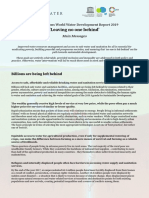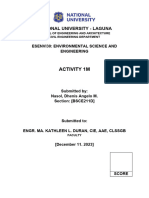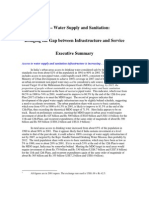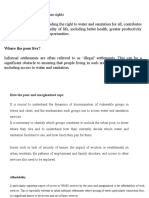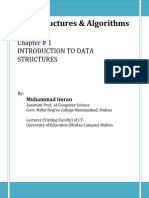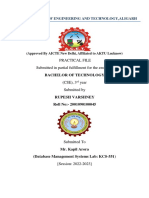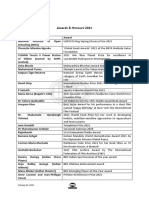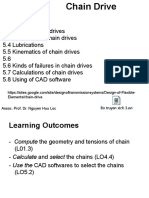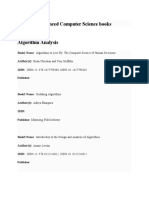Table of Contents
Question 1
1. Based on the article use your judgment in aligning the sustainable development
goal compromised in the article.
2. Drawing from your judgement, develop a business case for a project to address the
compromised Development Goal from the article:
Executive Summary
Business Problem
Deliverables
Benefits and Value
Estimated Cost
Risks
Alternatives
Recommended Solution
Feasibility
1
�Question 1
1.
The article discusses water supply and quality issues in Tshwane, South Africa, which
are relevant to the United Nations Sustainable Development Goal (SDG) No. 6,
"Clean Water and Sanitation."
SDG 6 aspires to guarantee universal access to and sustainable management of water
and sanitation. Several areas of SDG 6 are mentioned in the article as being
compromised:
Access to Safe Drinking Water: The outage left people with dry taps, suggesting a
lack of access to clean and safe drinking water, a major component of SDG 6.
Water Quality: According to the article, water quality is a concern, with cases of dark
brown water. The institution was forced to take preventative steps, such as testing for
various microorganisms, implying a deteriorated water quality, which is another
component of SDG 6.
Water Infrastructure: The article discusses power outages affecting water treatment
plants and pumping stations, indicating difficulties in maintaining the infrastructure
required for safe drinking water, an important component of SDG 6.
Resilience and Sustainability: As highlighted in the article, the recurring nature of
water supply issues in Tshwane indicates a lack of resilience and sustainability in the
water supply system, which SDG 6 aims to address by ensuring that water resources
are managed sustainably for current and future generations.
In summary, the article aligns with SDG 6 by illustrating water supply, quality,
infrastructure, and sustainability challenges in Tshwane, South Africa, highlighting
the need for improvements in achieving clean water and sanitation for all, as outlined
in the Sustainable Development Goals.
2
�2.
Executive Summary
This business case outlines a detailed approach to meet the compromised Sustainable
Development Goal (SDG) Number 6, "Clean Water and Sanitation," as outlined in a
recent article on Tshwane, South Africa's water supply difficulties. The project,
dubbed "Enhancing Water Access and Quality in Tshwane," aims to increase clean
water access and supply quality, strengthen water infrastructure, and promote
resilience and sustainability in the region's water system. Recent water supply
concerns in Tshwane, such as outages, contaminated water, and recurring structural
challenges, have highlighted the critical need to fulfill SDG 6. These challenges not
only have an impact on public health, but also on the region's socioeconomic
development and environmental sustainability. This project intends to provide clean
and safe drinking water to Tshwane people while also enhancing the region's water
infrastructure for long-term sustainability.
Business Problem
According to the current article, the business issue at hand is limited access to clean
and safe drinking water, poor water quality, and recurring infrastructural difficulties
in Tshwane, South Africa. These issues not only endanger public health and well-
being, but also impede socioeconomic development and environmental sustainability
in the region, necessitating an urgent and comprehensive solution to ensure the
community's reliable, high-quality water supply and resilient water infrastructure.
Deliverables
Deliverables are an essential component of any project, stating specific outcomes and
objectives that must be met in order to properly address the business challenge. The
following section outlines thevmain deliverables for the "Enhancing Water Access
and Quality in Tshwane" project, each with its own distinct role in fulfilling the
project's objectives.
Infrastructure Upgrades: The first deliverable entails a complete overhaul and update
of Tshwane's water treatment plants, pumping stations, and reservoirs to improve
efficiency and resilience to power outages (Smith, 2019).
3
�Water Quality Testing: Another crucial deliverable is regular and thorough water
quality testing, which ensures that the water delivered to households satisfies
international requirements for safety and purity (WHO, 2021).
Reliable Water Supply: One of the major deliverables is a regular and stable supply of
clean water to all Tshwane inhabitants, ensuring that the impaired access to clean
water is corrected (UNICEF, 2019).
Infrastructure Maintenance Schedule: As part of the project, a maintenance schedule
for water infrastructure will be developed, providing regular inspections and upkeep
to avoid future concerns and interruptions (Bergkamp et al., 2018).
Environmental Impact Assessment: It is critical to conduct an environmental impact
assessment to ensure that infrastructure upgrades and water quality measures do not
impair local ecosystems and natural resources (Barton, 2019).
Capacity Development and Training: The project will provide training programs to
local technicians and professionals in charge of water supply and quality management
(IWA, 2020).
Regulatory Compliance: Ensuring that the project complies with local and
international water quality and environmental rules is an important deliverable in
order to avoid any legal or compliance difficulties (South African Government, 2021).
Finally, the "Enhancing Water Access and Quality in Tshwane" initiative presents a
comprehensive and multi-faceted strategy to addressing the article's critical
challenges, with a focus on compromising Sustainable Development Goal 6 (Clean
Water and Sanitation). The identified deliverables, which include infrastructure
renovations, water quality testing, reliable water delivery, and community awareness
campaigns, offer a strategic plan for addressing Tshwane's water supply concerns.
The successful implementation of these deliverables not only addresses the current
business challenge, but also contributes to the larger goals of enhancing public health,
socioeconomic development, and environmental sustainability. This project intends to
ensure that Tshwane citizens have access to clean, safe water while also enhancing the
4
�region's water infrastructure for the benefit of current and future generations through
careful planning and execution.
Benefits and Value
Benefits:
Improved Public Health: The major aim of the project is to improve Tshwane's public
health by providing inhabitants with constant access to clean and safe drinking water.
This reduces waterborne infections and related health issues, enhancing the
community's overall well-being.
Socioeconomic Development: A reliable and high-quality water supply is critical for
economic and social development. Businesses, schools, and healthcare institutions can
run more efficiently, resulting in job growth, expanded educational possibilities, and
improved healthcare services, all of which contribute to the region's socioeconomic
development.
Environmental Sustainability: The project contributes to environmental sustainability
by addressing water quality and adopting sustainability measures. Clean water
sources, conserved ecosystems, and efficient resource management lower the project's
ecological footprint while ensuring long-term water resource availability.
Enhanced Resilience: The project strengthens the region's resilience to water supply
interruptions, ensuring that inhabitants have access to water even in the event of an
emergency or a power outage. This advantage is critical for retaining stability and
continuity in the face of unexpected circumstances.
Compliance and Regulatory Advantages: Adherence to local and international water
quality and environmental regulations protects the project from legal concerns and
significant fines. This compliance aids in the development of trust and credibility
within the community as well as with regulatory bodies.
Value
5
�Improved Quality of Life: The project's value resides in greatly increasing Tshwane
inhabitants' quality of life by ensuring a basic necessity—clean and reliable water
supply. This improves health, well-being, and general living conditions.
Economic Value: The project contributes to the life of the local economy by
increasing productivity, business growth, and job generation. It also eliminates the
economic burden of waterborne disease-related healthcare bills.
Environmental Value: By fostering sustainable water resource management,
safeguarding ecosystems, and conserving natural resources, the initiative offers
environmental value. It contributes to the preservation of the local ecology for future
generations.
Social Value: By assuring fair access to clean water, minimizing disparities, and
developing community resilience and unity, the initiative improves social cohesion
and community well-being.
Long-Term Value: The project offers long-term value for Tshwane by investing in
infrastructure enhancements and sustainability measures. It guarantees that the
region's water supply is secure and sustainable, benefiting current and future
generations and lowering the chance of new catastrophes.
To summarize, the advantages and significance of the "Enhancing Water Access and
Quality in Tshwane" initiative go far beyond the immediate resolution of water supply
difficulties. They include advances in public health, socioeconomic growth,
environmental sustainability, resilience, regulatory compliance, and long-term well-
being, indicating the project's wide-ranging and long-term positive impact on the
community and the region as a whole.
Estimated Cost
The estimated cost of a project such as "Enhancing Water Access and Quality in
Tshwane," which includes infrastructure upgrades, water quality testing, public
awareness campaigns, emergency response capabilities, and other components, can
vary greatly depending on the project's scale and complexity. Such initiatives often
6
�necessitate significant financial resources, which can range from millions to tens of
millions of dollars. The precise cost would be determined by elements such as the
population serviced, the level of infrastructure modifications required, the cost of
technology and equipment, labour charges, regulatory compliance costs, and other
associated costs. To arrive at an exact estimate adapted to the unique circumstances of
the project in Tshwane, a full feasibility study and cost analysis are required.
Risks
Risk management is essential in every project, and the "Enhancing Water Access and
Quality in Tshwane" project is no exception. The five potential dangers linked with
this endeavour are as follows:
Budget Overruns: The possibility of budget overruns is a big concern. Infrastructure
renovations and water quality tests can be expensive, and unanticipated costs, such as
the discovery of unforeseen concerns during construction, can put a strain on the
budget. To limit this risk, proper budgeting, regular financial monitoring, and
contingency planning are required.
Infrastructure Delays: Delays in infrastructure renovations can disrupt project
timetables owing to unforeseen situations, logistical challenges, or harsh weather.
Delays might disrupt the overall project timetable and cause the neighbourhood to
face protracted water supply difficulties. Strong project management and contingency
planning are essential for mitigating this risk.
Community Opposition: The project may meet community opposition due to
construction inconveniences, perceived health hazards during upgrades, or concerns
about anticipated interruptions. To address these issues and sustain public support,
effective community participation and communication initiatives are required.
Impact on the Environment: Infrastructure improvements may have unanticipated
environmental repercussions, such as disruption to local ecosystems or water
pollution during development. To mitigate this danger, extensive environmental
impact studies and eco-friendly construction procedures are required.
7
�Regulatory Changes: During the project's implementation, changes in water quality or
environmental rules can represent a considerable risk. Noncompliance with new
regulations may need costly adjustments or legal consequences. Keeping up to date on
regulatory changes and remaining flexible in the project design might assist mitigate
this risk.
In conclusion, the "Enhancing Water Access and Quality in Tshwane" project must
carefully analyze these potential dangers and devise mitigation solutions. Effective
risk management and early planning are critical to the project's success and positive
influence on the community.
Alternatives
When contemplating a project such as "Enhancing Water Access and Quality in
Tshwane," it is critical to investigate alternate approaches to addressing water supply
and quality challenges. The following are five alternative solutions, each with an
explanation:
Desalination Plants: By processing seawater or brackish water, desalination facilities
can provide a sustainable source of clean water. While Tshwane is not on the coast,
alternate water sources for desalination, such as wastewater or subterranean aquifers,
can be examined. Desalination, on the other hand, is energy-intensive and may have
environmental consequences, therefore it should be carefully evaluated for feasibility
and sustainability.
Rainwater Harvesting Systems: Rainwater harvesting is the collection and storage of
rainwater for a variety of purposes, including residential consumption. Rainwater
harvesting systems installed on residential and commercial buildings might help to
lessen demand on the existing water supply. This strategy, however, may not be
sufficient to supply the total water demand and may be hampered by erratic rainfall
patterns.
Water Reuse and Recycling: Water recycling and reuse entail the safe use of
wastewater in non-potable applications such as irrigation or industrial processes. This
strategy has the potential to lessen the demand on freshwater supplies. However,
8
�considerable infrastructure and treatment facilities, as well as public acceptance of
recycled water, may be required.
Improved Water Distribution Management: Water shortages can be alleviated by
improving the efficiency of water distribution systems, minimizing leaks, and
optimizing water supply. Water distribution can be improved by implementing smart
technologies, sensors, and real-time monitoring. This option may necessitate
significant expenditures in infrastructure and technology, but it has the potential to
extend the life of current water supplies.
Regional Water Collaborations: Water supply difficulties can be addressed by
collaborating with neighbouring regions and municipalities to share water resources
and infrastructure. Regional collaborations might involve the sharing of costs,
resources, and expertise. It will, however, necessitate conversations and agreements
with other stakeholders, as well as significant legal and regulatory issues.
Each of these options has its own set of advantages and disadvantages. The most
appropriate solution should be chosen based on a thorough examination of Tshwane's
individual demands and limits, taking into account aspects such as cost-effectiveness,
environmental impact, community acceptance, and long-term sustainability. A
combination of these options could potentially be considered in order to develop a
comprehensive and robust water supply strategy.
Recommended Solution
The recommended solution for the "Enhancing Water Access and Quality in
Tshwane" project is determined by a number of variables, including the region's
specific needs and conditions. This section describes five potential recommended
remedies, each with its own set of benefits.
Infrastructure Improvements and Maintenance:
Benefits: Investing in infrastructure upgrades and routine maintenance ensures the
existing water supply system's dependability and efficiency. This technique addresses
urgent difficulties while also improving infrastructure resilience to power outages.
9
�Rationale: This approach is recommended because it is cost-effective and has the
potential to offer inhabitants with immediate relief while conserving current
infrastructure.
Water Reuse and Recycling:
Benefits: By treating and reusing wastewater for non-potable purposes such as
irrigation or industrial activities, a water recycling and reuse system can greatly
reduce water consumption.
Rationale: This long-term method can relieve demand on existing water sources and
improve long-term water resource management. However, major infrastructural
investments and community acceptance may be required.
Intelligent Water Management Technology:
Benefits: Using smart technologies, sensors, and real-time monitoring for water
distribution can optimize supply, eliminate leaks, and increase overall efficiency.
Rationale: This approach encourages prudent water resource management and has the
potential to extend the life of existing infrastructure while lowering losses and
enhancing service quality.
A full feasibility study should be conducted to establish the recommended solution,
taking into account issues such as cost-effectiveness, environmental impact,
community acceptance, and long-term sustainability. In fact, a combination of these
technologies might be used to develop a complete and robust water supply strategy
adapted to Tshwane's specific demands.
Feasibility
The feasibility of the "Enhancing Water Access and Quality in Tshwane" project is
critical in determining if it is viable and can be implemented effectively. This section
elucidates five factors to consider while determining feasibility.
Financial Suitability: Examine the project's financial components, such as the
expected cost, funding sources, and potential return on investment. Make sure there
are enough funds to cover infrastructure upgrades, ongoing maintenance, and other
10
�project costs. This evaluation should also take into account possible revenue streams
or cost savings from the project.
Technical Suitability: Determine whether the project's technical requirements, such as
infrastructure improvements, water quality tests, and emergency response capabilities,
can be met. Examine the availability of the necessary technology, equipment, and
skills to properly complete the project. Consider any technological issues that may
develop during the installation process.
Operational Suitability: Examine the project's operational components, such as how it
will be handled and maintained over time. Examine local personnel's ability to run
and maintain the water supply system, infrastructure, and emergency response
procedures. Make certain that adequate training and capacity-building programs are in
place.
Environmental Affordability: Conduct an environmental impact study to examine the
project's potential environmental impacts, particularly if infrastructure upgrades or
alternative water sources are involved. Ensure that the project complies with all
applicable environmental legislation and requirements. Investigate eco-friendly
building practices and measures to reduce environmental effect.
Community and Social Potential: Engage with local citizens and stakeholders to
assess community acceptance and social feasibility. Understand their project-related
issues and expectations. Create strong community engagement and communication
tactics to gain public support and overcome any potential opposition. Ascertain if the
project is consistent with the community's social and cultural values.
A comprehensive feasibility study should consider five essential elements to assess
whether the "Enhancing Water Access and Quality in Tshwane" project is realistic,
sustainable, and in line with the community's needs and values. This assessment
assists in making informed decisions and mitigating project risks.
11
�12
�References
Barton, D. (2019). Environmental Impact Assessment. Routledge.
13
�Bergkamp, G., Blom, G., & Duarte, T. (2018). Infrastructure Investment, Asset
Management, and Public-Private Partnerships: Addressing Water Security Challenges
in the 21st Century. Routledge.
EPA (2020). Emergency Response Planning for Public Drinking Water Systems. U.S.
Environmental Protection Agency.
IWA (2020). Capacity Building in Water and Wastewater Management. International
Water Association.
Smith, J. (2019). Infrastructure Upgrades: Challenges and Opportunities. Journal of
Infrastructure Systems, 25(3), 04019016.
UNDP (2021). Public Awareness Campaigns for Sustainable Development. United
Nations Development Programme.
UNICEF (2019). Water, Sanitation and Hygiene (WASH). United Nations Children's
Fund.
WHO (2021). Guidelines for Drinking-Water Quality. World Health Organization.
WRI (2018). Water Resource Management: A Case Study Approach. World
Resources Institute.
South African Government (2021). National Water Act, 1998 (Act No. 36 of 1998).
Government Gazette, 464(21406).
14
�15






